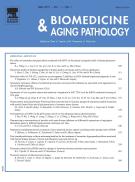Matricaria Chamomilla extract demonstrates antioxidant properties against elevated rat brain oxidative status induced by amnestic dose of scopolamine - 22/10/14

Abstract |
Alzheimer's disease (AD) is clinically characterized by progressive loss of cognitive abilities and usually is accompany with elevated oxidative stress. Chamomile is a plant with antioxidant activity with is currently used in Iranian folk medicine as sedative, analgesic, antipyretic and antispasmodic agent. The present study was investigated the effect of Matricaria chamomilla (MC) on learning and memory functions in scopolamine-induced memory deficit in rats. Memory enhancing activity in scopolamine-induced amnesic rats was investigated by assessing the Morris water maze and passive avoidance paradigm. Forty-two male Wistar rats were divided into 6 equal groups as bellow: 1 – control (received water), 2 – SCOP (received scopolamine 1mg/kg for 15days), 3 and 4 – SCOP+MC (received scopolamine and MC extract 200 and 500mg/kg b.w. per day for 15days), 5 and 6 – intact groups (received MC extract 200 and 500mg/kg b.w. per day for 15days). M. Chamomilla ethanolic extract produced significant memory enhancing activity when evaluated by Morris water maze and passive avoidance paradigm models. Our results suggest that M. chamomilla ethanolic extract has repairing effects on memory deficit and might be beneficial in patients with Alzheimer's disease and behavioral disorders. The memory enhancing activity of the extract may be attributed to the free radical scavenging activity, which would have been afforded by the active constituents present in the extract.
El texto completo de este artículo está disponible en PDF.Keywords : Matricaria Chamomilla, Alzheimer's disease, Scopolamine
Esquema
Vol 4 - N° 4
P. 355-360 - octobre 2014 Regresar al númeroBienvenido a EM-consulte, la referencia de los profesionales de la salud.
El acceso al texto completo de este artículo requiere una suscripción.
¿Ya suscrito a @@106933@@ revista ?

